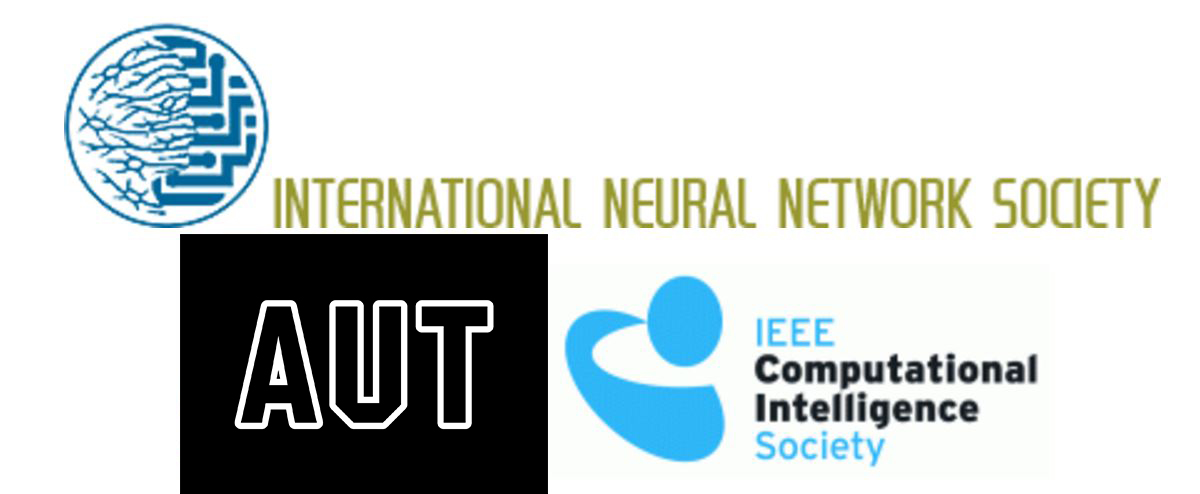Neuroinformatics seminars
Seminar by Dr Ina Taralova on Tuesday 29th May
Venue: WT712
Date & Time: 29th May 2018 at 1 pm
On 29th May, Dr Ina Taralova visited KEDRI to give a talk about her research on “Juxtaposition of control theory and nonlinear dynamics for chaos-based secure information transmission”. Dr Taralova is an Associate Professor at Ecole Centrale de Nantes in France, and researcher at the Laboratory of Digital Sciences of Nantes (LS2N). Her main scientific interests are in the fields of nonlinear system dynamics, chaos and bifurcations in discrete-time systems, synchronisation of chaotic systems, observer synthesis, and design of pseudo-random number generators. She is currently Deputy director for international students at Ecole Centrale de Nantes; scientific coordinator of national and international research projects and leader of the research axis “chaotic systems” at LS2N.
Auckland AI and Machine Learning Meetup
On 27th March, Professor Kasabov will hold a presentation at the Auckland AI and Machine Learning Meetup, titled “Spiking Neural Networks and Brain-Inspired Artificial Intelligence”. He will talk about recent advances in Brain-Inspired AI (BI-AI) and give several examples of applications. The meetup will be held from 6 p.m. at IBM’s Auckland office. More information can be found on the registration website: https://www.meetup.com/de-DE/Auckland-AI-Meetup/events/248619453/
KEDRI Seminar
Title: Salient Object Detection Based on Saturation of Visual Perception
Presenter: Dr. Chen Pan, China Jiliang University, Hangzhou China
Venue: WT 712
Date & Time: 25th Jan 2018 at 1 p.m.
Abstract:
Humans show visual attention by using a series of eye movements. Eye movement has two forms: saccades and microsaccades. The integration of saccades and microsaccades contributes to the rapid and efficient performance of human vision system. Inspired by our observations, we think the visual saturation caused by microsaccades in gaze should be the main factor that drives human brain to output awareness of an object. Visual saturation may be indicated by using the amplitude of microsaccades (AOM). When the AOM or the change of AOM closes to zero, the visual perception becomes saturated.
Motivated by this observation, we construct a group of learning-based models to detect salient object from coarse to fine. First, small scale image is selected according to the minimized AOM in order to promote saturation of human perception and reduce amount of data. Random weight neural networks (RWNNs) are used to simulate human brain to accept visual stimuli and produce new one just like nerve firing. In order to examine the change of AOM, a positive feedback loop is constructed which executes the procedure of "pixel sampling-learning-classification" iteratively against fixation area. The final fixation area of the loop is salient object. The proposed algorithm is data driven totally and need no labelling samples manually. Experiments on several standard image databases show that our method not only achieves better performance compared to the bottom-up algorithms, but also improves the performance of the existing methods.
Bio-data:
Dr Chen Pan is a professor with the College of information engineering, China Jiliang University (CJLU), Hangzhou China. His research interests include computer vision, image processing and machine learning, especially in the direction of image processing algorithms that simulate human visual mechanisms. Professor Pan has published more than 50 research papers.
KEDRI Seminar
Speaker: Prof. Jie Yang, Shanghai Jiao Tong University
Seminar: ‘Recent research on Brain-inspired Modelling and its applications’
Date & Time: Thursday, 7th December 2017, 1 p.m.
Venue: WT712
Abstract: Saliency detection is an effective way to acquire potential regions of interest that may attract human eyes. Its numerous applications range from object detection and recognition, image compression, video summarisation, to content-based image editing and image retrieval. Towards better grouping of objects and background, a method based on Normalised graph cut (Ncut) is proposed for saliency detection. Since the Ncut partitions a graph in a normalised energy minimisation fashion, resulting eigenvectors of the Ncut contain good cluster information that may group visual contents. Motivated by this, the proposed method directly induces saliency maps via eigenvectors of the Ncut, contributing to accurate saliency estimation of visual clusters.
Given a few labelled samples, semi-supervised learning generally performs much better than supervised learning. Semi-supervised learning algorithms are more robust to noise. Label Prediction via Deformed Graph Laplacian for Semi-supervised Learning is presented. A novel curriculum learning approach, dubbed multi-modal curriculum learning, to optimise the quality of semi-supervised image classification is proposed.
About the Speaker:

Jie Yang received a bachelor’s degree in Automatic Control in Shanghai Jiao Tong University, and a Master’s degree in Pattern Recognition & Intelligent System was achieved three years later. In 1994, he received a Ph.D. at the Department of Computer Science, University of Hamburg, Germany. At present, he is the Professor and Director of Institute of Image Processing and Pattern recognition in Shanghai Jiao Tong University. He is the principal investigator of more than 30 national and ministry scientific research projects in image processing, pattern recognition, data mining, and artificial intelligence, including two national ‘973 research plan projects’, three national ‘863 research plan projects’, four ‘National Nature Foundation projects’ and six international cooperative projects with France, Sweden, Korea, Japan, New Zealand. He has published five books, more than five hundred articles in national/international academic journals and conferences. To date, he has supervised 5 postdocs, 36 PhDs and 66 Masters. He was awarded six research achievement prizes from the Ministry of Education, China, and Shanghai municipality. Two Ph.D. dissertations he supervised were evaluated as “National Best Ph.D. Dissertation” in 2009 and in 2017 and two more Ph.D. dissertations were evaluated as “Shanghai Best Ph.D. Dissertation” in 2009 and 2010. Prof. Yang has 32 patents.
Jade Innovation Showcase
Topic: Neural Networks, Deep Learning and Neuromorphic AI
Speaker: Prof. Nikola Kasabov
Date & Time: 27/09/2017 at 10 am to 12 pm
Location: JadeWorld Building, 5 Sir Gil Simpson Drive, Christchurch.
RSVP Contact details: hr@jadeworld.com by 15/09/2017
For more information please see here.
2017 GIBBONS LECTURES IN ASSOCIATION WITH ITP
The Computer Science Department at the University of Auckland, in association with IT Professionals New Zealand, is pleased to announce the Gibbons Lecture Series for 2017. This year the lectures address aspects of the Steps Towards the Singularity: Artificial Intelligence and its Impact. Machines that mimic cognitive functions which humans associate with other human minds, such as learning and problem solving, are said to be exhibiting Artificial Intelligence or AI. In this series of lectures we will explore what is happening locally. Setting the scene, our lead speaker for 2017, Professor Nikola Kasabov, from Auckland University of Technology, will discuss the progress of AI from its deepest roots to current research frontiers. Of personal interest to many of us, Professor Hans Guesgen, from Massey University, will be talking about the use of AI to improve the lot of elderly citizens. Associate Professor Marcus Frean, from Victoria University of Wellington, will take a more-critical look at the current hot topic of deep learning. Ending the lecture series, with a discussion of the questionable impacts of AI, will be Associate Professor Ian Watson from the University of Auckland.
Lecture 1: AI: From Aristotle to Deep Learning Machines
Speaker: Prof. Nikola Kasabov, Auckland University of Technology
Date & Time: 4 May 2017: 6:00 pm - 7:30 pm
Presentation File: PDF
Venue: University of Auckland, Owen G Glenn Building, Room OGGB 3/260-092, Level 0, 12 Grafton Road, Auckland. (There is public parking in the basement of the Owen G Glenn Building at 12 Grafton Road)
Registration: Attendance is free. Please see details for registration
https://itp.nz/events/auckland/1444-2017_Gibbons_Lecture_1_AI_From_Aristotle_to_Deep_Learning_Machines_
Abstract:
The talk presents briefly the main principles used in AI, from Aristotle's true/false, logic, through fuzzy logic, evolutionary computation and neural networks, to arrive at the current state-of-art in AI - the deep learning machines. One particular implementation, dubbed NeuCube, developed in the presenter's KEDRI institute, is designed for deep learning of complex data patterns, both in space and time, and to predict future events. It uses the latest AI techniques called spiking neural networks (SNN) that mimic the learning capabilities of the human brain. This NZ invention has already been demonstrated on various spatio-temporal data and problems, including: brain EEG and fMRI data; brain-computer interfaces; seismic data for earthquake prediction; environmental data for individual stroke prediction; and others. This is the beginning of understanding complex patterns of changes of variables in Space and Time and their relevance to future events. This is one of science’s biggest challenges and has an enormous impact on our understanding of the dynamics of the micro and the macro worlds; from molecular and brain functioning, to geophysical phenomena, and the universe. More information, along with software and data, can be found in: http://www.kedri.aut.ac.nz.
About the speaker:

Nikola Kasabov received his PhD (Mathematical Sciences) in 1975 from the Technical University of Sofia. He moved to the University of Essex in the UK and, in 1992, to New Zealand as a senior lecturer in the Department of Information Sciences at the University of Otago, quickly advancing to a Professorship by 1999. He moved to AUT in 2002 where he is now the Director of the Knowledge Engineering & Discovery Research Institute and holds a Professorship in Knowledge Engineering in the School of Engineering, Computer and Mathematical Sciences. He has published over 600 works, including 180 journal papers, 12 text books, 28 patents. He has received numerous awards for the quality of his copious research output. He is a Fellow of the IEEE, the IITP and the RSNZ. Professor Kasabov has research interests in Neurocomputation, Artificial Intelligence (Neural Networks, Fuzzy Systems, Evolutionary Computation), Machine Learning, Data Mining and Knowledge Engineering, Neuroinformatics, Bioinformatics. Much of his current research in the KEDRI institute is based around his NeuCube neurocomputing technology which is being applied to learning and pattern recognition of spatio-temporal data. More information can be found at: around his NeuCube neurocomputing technology which is being applied to learning and pattern recognition of spatio-temporal data. More information can be found at: http://www.kedri.aut.ac.nz.
KEDRI SEMINAR
Speaker: Dr. Evgeny Bogomolny, Scientific Consultant, BMS,
Date: Thursday 20th April 2017
Time: 1 p.m.
Venue: WT712
Title: Multivariate analysis in biomedical research: Chemometrics of IR and Light induced Fluorescence (LIF) spectroscopy for cancer diagnosis and microorganism detection
Abstract:
The objective of the presentation is to review the application of advanced multivariate data-analysis techniques in the field of mid-infrared and Light Induced Fluorescence (LIF) spectroscopic biomedical diagnosis. The optical signal has a rich chemical information allowing to characterize versatile biological processes. However, due to the complexity, it is frequently difficult to interpret spectral features by simple data-analysis approach. Range of mathematical and statistical data tools such as Principal Component Analysis (PCA), Partial Least Squares (PLS), K-means clustering, Linear Discriminant Analysis and others are required for deconvoluting spectroscopic data and providing meaningful regression and prediction models. The representative studies of cancer diagnosis and microorganism detection will be demonstrated with particular emphasis on the advantageous use multivariate approach.
KEDRI SEMINAR
Speaker: Dr. Peyman Sebouri, AUT
Date: Thursday 20th April 2017
Time: 1.30 p.m.
Venue: WT712
Title : “Skin cancer detection using image processing and machine learning”
Abstract: This presentation mainly focused on two main areas: deploying image processing algorithms on skin lesion images and applying efficient machine learning algorithms for skin lesion classification. Skin cancer is among the top twenty most common cancers and it can be divided into two main categories: melanoma and non-melanoma. Malignant melanoma is one of the leading causes of death due to skin cancer especially in New Zealand and Australia. It is widely accepted that early diagnosis of melanoma significantly reduces morbidity, mortality and the cost of medication.
KEDRI OPEN LECTURE SERIES 2016
Speaker: Professor Ying Tan of Peking University, China
Topic: Advance in Swarm Intelligence Algorithms: Principle, Algorithms and Applications of Fireworks Algorithm
Date: Thursday, 19th May 2016
Time: 1 p.m.
Venue: WT712
Abstract:
Recently, inspired from the collective behaviors of many swarm-based creatures in nature or social phenomena, swarm intelligence (SI) has received attention and has been studied extensively, gradually becomes a class of efficiently intelligent optimization methods. Inspired by fireworks explosion at night, the fireworks algorithm (FWA) was developed in 2010. Since then, several improvements and some applications were proposed to improve the efficiency of FWA. In this talk, the fireworks algorithm is first described in detail and reviewed, then several effective improved fireworks algorithms are highlighted individually. By changing the ways of calculating numbers and amplitudes of sparks in fireworks’ explosion, the improved FWA algorithms become more reasonable and explainable. In addition, the multi-objective fireworks algorithm and the graphic processing unit (GPU) based FWA are also briefly presented, particularly the GPU-based FWA which is able to speed up the optimization process considerably. Extensive experiments on IEEE-CEC’s benchmark functions demonstrate that the improved fireworks algorithms significantly increase the accuracy of found solutions, yet decrease the running time dramatically. Finally, some applications of FWA are briefly described, while its shortcomings and future research directions are identified.
KEDRI OPEN LECTURE - Prof. Massimiano Bucchi
Speaker: Prof. Massimiano Bucchi, University of Trento, Italy
Topic : The Crisis of Mediators? Science Communication in the Digital age
Date: Monday, 22nd February 2016
Time: 1 p.m.
Venue : WT712
Abstract:
More than 25 years after the Royal Society report on Public Understanding of Science, there is hardly any doubt that science communication efforts aimed at non expert audiences have increased in quantity and intensity on a global scale. Public engagement and outreach activities have now become a routine – when not a prominent - feature for several research institutions in Europe. Budget and human resources are devoted to these activities, and researchers themselves are increasingly and even institutionally encouraged to pursue this ‘third mission’ alongside more traditional research and teaching duties. Does this ever more pressing public relations push, together with the increasingly central role of digital media and by research institutions, substantially undermine the role of traditional mediators of science communication (e.g. newspapers, magazines, TV/Radio shows and science museums and centres) as filters and warrants of the quality of information? What are the key challenges in this new context of ‘Science Communication’?
Massimiano Bucchi is Professor of Science and Technology in Society and of Science Communication at the University of Trento, Italy and has been visiting professor in several academic and research institutions in Asia, Europe and North America.
He has published several books (published in Italy, Brazil, Finland, China, Korea, UK and USA, Spain and Latin America), including Science in Society (London and New York, Routledge, 2004), Beyond Technocracy (New York, Springer, 2009) and Handbook of Public Communication of Science and Technology (ed. with B. Trench, London & New York, Routledge, 2014) and papers in journals such as Nature and Science. In 2016 he will become editor of the international peer reviewed journal Public Understanding of Science (Sage).
https://unitn.academia.edu/MassimianoBucchi
KEDRI Open Lecture
Date: Friday, 19th February 2016
Time: 1 p.m.
Venue : WT712
Speaker: Dr. Steve Weddell
Topic : Research in reservoir computing at University of Canterbury
Abstract:
Over the last 10 years the Computational Design & Adaptation (CDA) group in the Department of Electrical & Computer Engineering at UC has been researching and developing new structures and platforms for selective use of reservoir computing.years the Computational Design & Adaptation (CDA) group in the Department of Electrical & Computer Engineering at UC has been researching and developing new structures and platforms for selective use of reservoir computing.
For this seminar Dr. Weddell will discuss the past and current research projects in reservoir computing and outline how this work has been applied in several specialised fields of image processing, biomedical, and neural engineering for control, classification and prediction, and more specifically, for astronomical image restoration and microsleep detection.
---------------------------------------------------
Dr. Steve Weddell is a Senior Lecturer in the Department of Electrical & Computer Engineering at the University of Canterbury. He is the manager of the CDA group and specializes in signal processing, artificial neural networks, and embedded systems. Dr. Weddell is currently on sabbatical leave but will return to his previous position as Director of Computer Engineering Studies in ECE later this year.
25th November 2015 - NeuLab Opening
NeuLab Opening:

The Vice Chancellor opened KEDRI’s NeuLab, the first and perhaps the only neurocomputing laboratory in NZ, on 25th November at 4 p.m. It is an advanced data science laboratory that will have an important role in relation to the global big data challenges. The NeuLab offers advanced generic data analytics owned as IP by AUT, including the NeuCube system based on the latest development of spiking neural networks, an EEG laboratory, VR visualisation, robotic techniques and others. The plan is to make the NeuLab an incubator for new research on complex data that can result in new scientific publications, new PhD studies, new technologies across applications in health, engineering, environment and business through collaborative work at AUT, nationally and internationally.
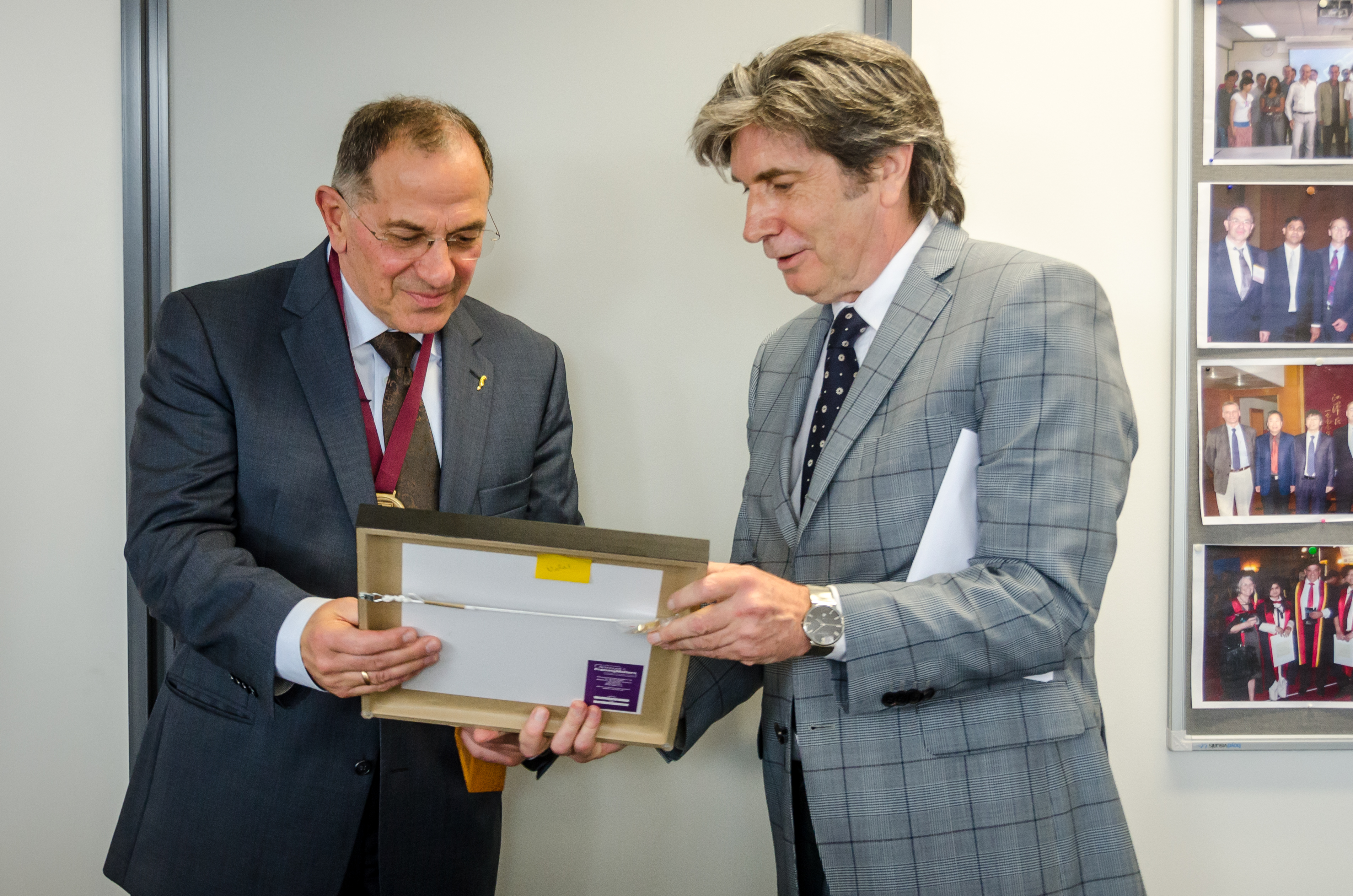
The Vice Chancellor took the opportunity of awarding the University Medal to Prof. Nikola Kasabov in person as he was unable to attend the VC’s Excellence Awards on 22nd October 2015.
14th November 2014 - KEDRI OPEN LECTURE by Prof. Jie Yang
Professor Jie Yang, from the Institute of Image Processing and Pattern Recognition of Shanghai Jiao Tong University in China, gave a Lecture on "Recent Research On Machine Learning and Image Processing” at 1PM in WT712.
Abstract: Presentations on recent research on Machine Learning and image processing in Lab. PAMI, Shanghai Jiao Tong University, such as: ReLISH: Reliable Label Inference via Smoothness Hypothesis (presented at AAAI2014 and accepted by TNNLS) ; A diversity-enhanced condensation algorithm and its Application for robust and accurate endoscope three-dimensional motion tracking (presented at CVPR2014); Unsupervised Segmentation Using Cluster Ensembles (presented at ICONIP2014).
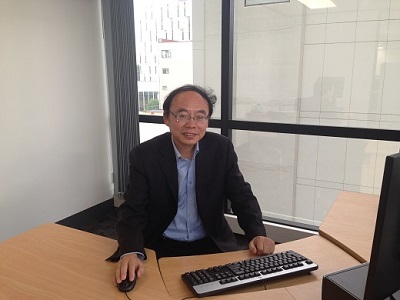
Prof. Jie Yang received a Bachelor’s degree in Automatic Control in Shanghai Jiao Tong University, where a master’s degree in Pattern Recognition & Intelligent System was achieved three years later. In 1994, he received Ph.D. at Department of Computer Science, University of Hamburg, Germany. Currently he is the Professor and Director of Institute of Image Processing and Pattern recognition in Shanghai Jiao Tong University. He is the principal investigator of more than 30 national and ministry scientific research projects in image processing, pattern recognition, data mining, and artificial intelligence. He has published five books and more than five hundred articles in national and international academic journals and conferences. He has 32 patents. Till now, Prof. Yang has supervised 5 postdoctoral fellows, 42 PhD and 80 Masters students. One of the Ph.D. dissertations he supervised was evaluated as “National Best Ph.D. Dissertation” in 2009. He has been awarded six research achievement prizes from the Ministry of Education, China and Shanghai Municipality.
19-20 February 2015 - 13th Conference on Neuro-Computing and Evolving Intelligence (NCEI'15)
The 13th Conference on Neuro-Computing and Evolving Intelligence (NCEI’15) will be held on February 19-20, 2015 at Auckland University of Technology, WG Sir Paul Reeves Building, level 1, room 126, 2 Governor Fitzroy Place, Auckland 1010, New Zealand. The theme of the conference is 'Intelligence Information Technology for Big Data'.
15th November 2013 - Tripartite Project Workshop
As a form of cooperation between AUT, Xinjiang University, and Shanghai Jiaotong University under the NZ-China Tripartite project, a workshop was held in Lincoln University’s Bio-Protection Research Centre on 15th November 2013 in Christchurch.
Prof Jie Yang and PhD Student Enmei Tu from Shanghai Jiaotong University and Assoc Prof Russel Pears and PhD Student Reggio Hartono from KEDRI attended the workshop.
Everyone presented their research and shared their knowledge to enable collaboration between the institutes. Lincoln University PhD student Audrey Lustig made a follow-up visit to Auckland the week after to discuss her research with the team at KEDRI.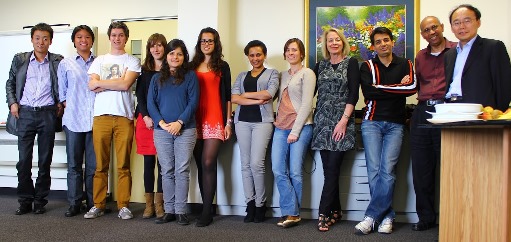
Date & Time: Friday, 15th Nov. 2013.
Venue: Bio-Protection Research Group, Lincoln University, Christchurch.
28th February 2013 - Machine learning, modelling and understanding of brain data with applications across disciplines: Launching the KEDRI new NeuCube Project
The KEDRI new project, named NeuCube, is about developing new information methods and technologies for brain data analysis, modelling and understanding, such as EEG, fMRI, MEG, genetic and other various spatio-temporal brain data, with applications across disciplines, including: information and computer sciences; engineering; environmental and health sciences; cognitive science; neuroeconomics; art and design; communication; sport; medical and clinical practice. Exemplar applications are: brain-computer interfaces; neurorehabilitation; robotics; emotional computing; decision making; human- computer and human-to-human communication. In its interdisciplinary content, this is the world-first and a long-term project, involving KEDRI and other groups from AUT (NISAN, SCMS) in collaboration with China Academy of Sciences and several European partners. It also relates to a new special topic paper 408214 offered by the SCMS this semester. The team is led by Prof. Nik Kasabov. Both the project and the paper are open for new participants to join with their specific research topics. The seminar will include presentation and demonstration by the team followed by open discussions.
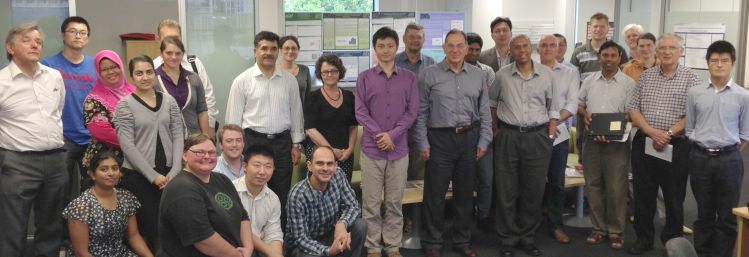
Date & Time: Thursday, 28th Feb. 2013 at 1 p.m.
Venue: WY315 (Level 3, 120 Mayoral Drive)
8th June 2012 - 12th Conference on Neuro-Computing and Evolving Intelligence (NCEI'12)
NCEI’12 conference/workshop is a continuation of a previous conference series in NZ - ANNES, established in 1993. This conference aims at promoting research and development activities focused on advanced intelligent computing techniques by providing a vibrant and effective forum across a variety of disciplines. The scope of the conference includes a range of techniques such as Artificial Intelligence, Neural Networks, Evolutionary Computing, Brain Computer Interfaces, Informatics Theory and Applications, Computational Neuroscience, Neuromorphic computation, Bioinformatics, Pattern Recognition, Data Mining and Health Informatics.
The NCEI 2012 workshop was organized as a pre-conference workshop held just before the WCCI'12 in Brisbane, Australia (June 10-15, 2012).

Special session at the WCCI
Title: Spiking Neural Networks for Spatio- and Spectro-Temporal Data Modelling and Pattern Recognition: Methods, Systems, Applications
Date: 10 -15 June 2012
3 April 2012 - KEDRI Open Lecture on "Advanced Algorithms for Machine Learning and Remote Sensing Image Analysis" by Prof. Jie Yang
Advanced algorithms for machine learning are presented, such as Improved Feature Selection Algorithms for High-Dimensional Data; Improved Soft Subspace Clustering; Dimensionality Reduction by Manifold Learning. A system for remote sensing image analysis is presented, its application for ecological environment monitoring in Xinjiang Province, China is demonstrated.
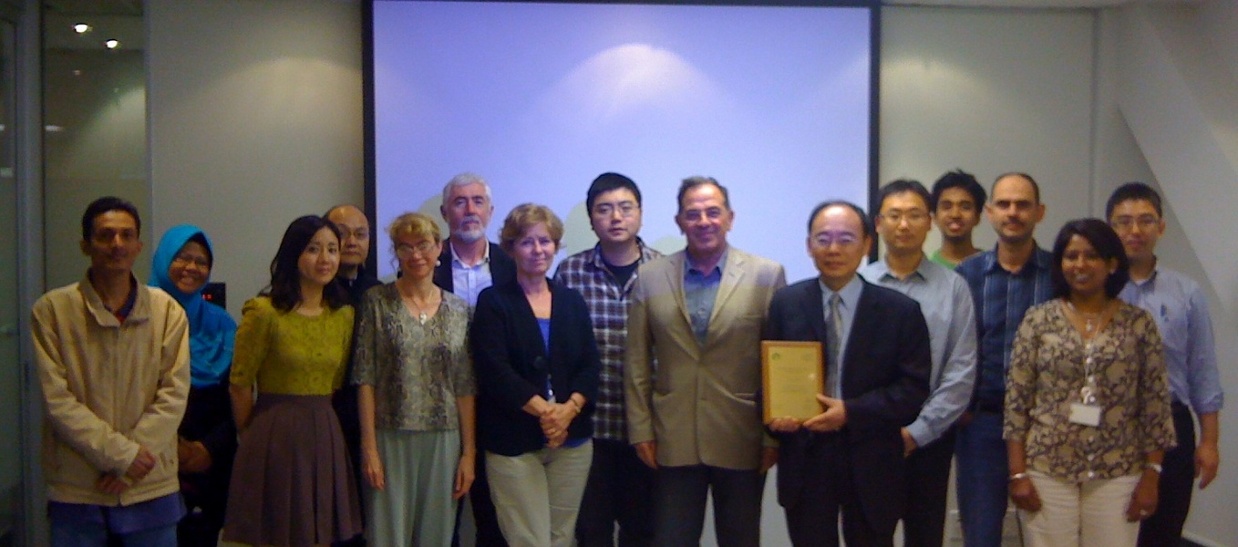
Biography
Prof. Jie Yang received a bachelor degree in Automatic Control and a master degree in Pattern Recognition & Intelligent System in Shanghai Jiao Tong University. He received his Ph.D. at the Department of Computer Science, University of Hamburg, Germany in 1994. He is the Professor and Director of the Institute of Image Processing and Pattern recognition in Shanghai Jiao Tong University. He is the principal investigator of more than 30 nation and ministry scientific research projects in image processing, pattern recognition, data mining, and artificial intelligence, including two national 973 research plan projects, three national 863 research plan projects, three national nature foundation projects, five international cooperative projects with France, Korea, Japan, New Zealand. He has published more than 5 hundreds of articles in national or international academic journals and conferences.
7
February
2012 - KEDRI Open Lecture on "Intelligent Systems: An Assessment of the Past and the Prospects for the Future" by Prof. Okyay Kaynak
The KEDRI Open Lecture is being sponsored by School of Engineering and School of Computing and Mathematical Sciences.
The last decade of the last millennium is characterized by what might be called the intelligent systems revolution, as a result of which, it is now possible to have man-made systems that exhibit ability to reason, learn from experience and make rational decisions without human intervention. Prof. Zadeh has coined the word MIQ (machine intelligence quotient) to describe a measure of intelligence of man-made systems. In this perspective, an intelligent system can be defined as a system that has a high MIQ.
In the presentation the state-of-art reached in intelligent systems is overviewed with examples and a perspective on the future is given. The reasons behind the slow pace of developments are discussed. The talk closes with a consideration of the possible research directions in mechatronics and robotics as driving forces behind the development of intelligent systems.
Presenter: Prof. Okyay Kaynak,
UNESCO Chair on Mechatronics,
Bogazici University, Bebek, 34342 Istanbul, Turkey
3 March 2011 - KEDRI Seminar by Dr. Gisela Klette on "A Recursive Algorithm for the Computation of the Relative Convex Hull"
The relative convex hull of a simple polygon A, contained in a second simple polygon B, is known to be the minimum perimeter polygon (MPP).
Digital geometry studies a special case: A is the inner and B the outer polygon of a component in an image, and the MPP is called minimum length polygon (MLP). The MPP or MLP, or the relative convex hull, are uniquely defined. The paper recalls properties and algorithms related to the relative convex hull, and proposes a (recursive) algorithm for calculating the relative convex hull. The input may be simple polygons A and B in general, or inner and outer polygonal shapes in 2D digital imaging. The new algorithm is easy to understand, and is explained here for the general case. The worst case time complexity is quadratic, but it runs for "typical'' (as in image analysis) inputs in linear time.
Biography
Dr. Gisela Klette has a Master’s degree in Mathematics from the Friedrich-Schiller-University (Jena, Germany) and a PhD in medical image analysis from the University at Groningen (The Netherlands). She was working in a combined teaching and research position at the University of Auckland between 2002 and 2007. She is now a part-time lecturer at AUT.
Her research interests are in medical image analysis, in particular in applications of discrete geometry. She is a reviewer for journals such as IEEE Transactions in Pattern Analysis and Machine Intelligence, Theoretical Computer Science and Acta Cybernetica.
23 February 2010 – KEDRI Seminar on ”On the Puzzle of the Induction/Deduction Loop Bridging Perception and Symbolic Reasoning” and “Graphical Pattern Recognition: the LSRN Approach”
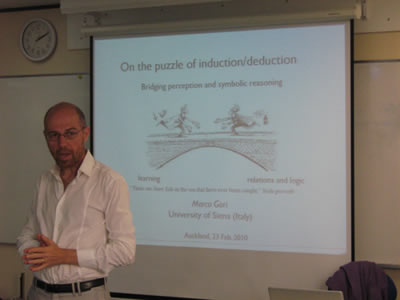
Speaker: Prof. Marco Gori
Title: On the Puzzle of the Induction/Deduction Loop Bridging Perception and Symbolic Reasoning
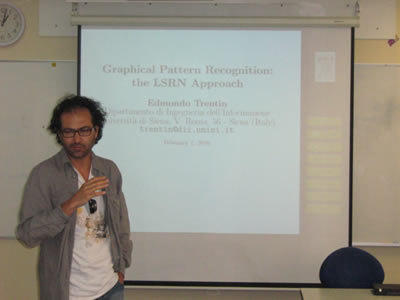
Speaker: Prof. Edmondo Trentin
Title: Graphical Pattern Recognition, the LSRN Approach
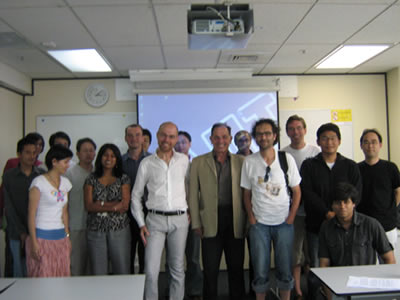
Prof. Marco Gori and Prof. Edmondo Trentin together with seminar participants
10 December 2009 – AUT Summer Graduation
On the AUT Summer Graduation day, three of KEDRI's PhD students had graduated - Anju Verma, Snjezana Soltic and Peter Hwang and three of KEDRI's Matsers students had also graduated with a First Class - Linda Liang, Sean Gordon and Peter Wang.
In addition to that, one KEDRI’s PhD student, Stefan Schliebs has received the Dean's Award for the Best Postgraduate Study in the School.
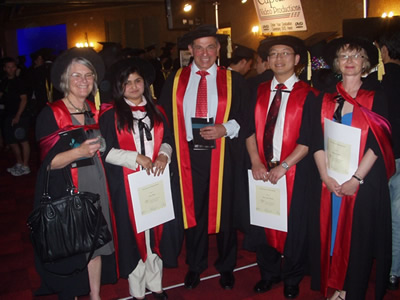
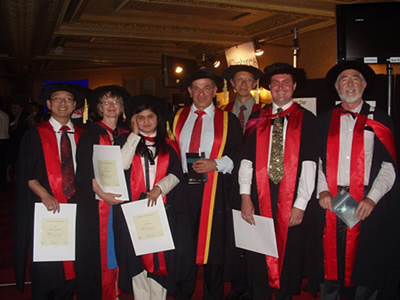
6 August 2009 – KEDRI Seminar on Kinetics models and laser photolysis
Title: Analysis of synaptic transmission and its regulation by channel
Speaker: Prof. Hiroshi Kojima, Laboratory for Cellular and Molecular Physiology, Tamagawa University, Tokyo Japan
The presentation will introduce the physiological experiments and techniques which enable us to understand the background of the synaptic transmission. Then it will explain how the rate constants of AMPA receptor channel kinetics model of neural cells which could induce the change in efficacy of synaptic transmission can be predicted with computer simulation.
Excitatory postsynaptic currents (EPSCs) were reconstructed by computer calculation. Moreover, electrical responses were measured from neurons by using laser uncaging experiments. It was shown that the properties of the evoked current responses by photolysis and those obtained spontaneous synaptic currents have the similar properties. It is also suggested that the present method based on kinetics models and uncaging method could be used for the investigation of the integration and regulation by neural cells.
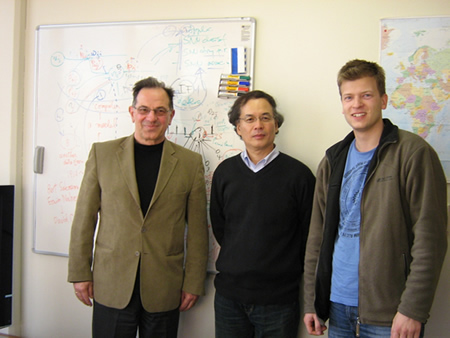
On the photo from left to right: Prof. Nikola Kasabov (KEDRI), Prof. Hiroshi Kojima (Tamagawa University), Stefan Schliebs (KEDRI)
11th December 2008 - KEDRI seminar on "Progress and challenges in vision-based driver assistant systems"
Speaker: Professor Reinhard Klette, Computer Science Department, University of Auckland
The talk will discuss computer vision challenges in the context of vision-based driver assistant systems, certainly one of the most difficult areas of current 3D image analysis due to (1) the expectation of being "legally soundproof" at night or in the rain, at 120km/h, in Queen Street at rush hour, and so forth, also due to (2) the real time request, and (3) expectations to look about 3 seconds ahead - what may happen next in front of the car, at the location where the ego-vehicle is expected to be? Actually, car companies have started in 1995 to add vision solutions into their top-end models. What can we add to this in New Zealand, without having any car production line in the country? The talk will suggest collaboration between KEDRI/AUT an the .enpeda.. team.
21st and 28th February 2008 - KEDRI seminars on Technical characteristics and programming of the mobile robot "WITH"
Topic: Technical characteristics and programming of the mobile robot "WITH"
Presenter: Mr. Ryota Nishioka PhD student, Kyushu Institute of Technology (KIT), Japan
Supervisor: Prof. Takeshi Yamakawa
The speaker will present some technical characteristics, programming, details and instructions as to how to develop applications for the robot "WITH" built at the KIT. The robot is now available at KEDRI for joint projects based on the collaboration agreement between KEDRI/AUT and KIT.
Suggestions for new projects based on this robot should be sent to Dr. Paul (Shaoning) Pang: spang@aut.ac.nz
15th International Conference on Neural Information Processing of the Asia-Pacific Neural Network Assembly, APNNA (ICONIP’ 08), November 25-28, 2008, Auckland, NZ
Technical co-sponsorship: APNNA, INNS, JNNS, ENNS, IEEE CIS
Preceded by the INNS 2008 Symposia on “New Directions in Neural Networks” (INNS-NNN), 24-25 November '08
Objectives: Neuro-Information Processing is an area of science concerned with the development, implementation, realisation and application of computational models that mimic the brain in its main functions of adaptive learning, predictive generalisation, knowledge discovery, creative thinking. Applications span across all disciplines, e.g.: neuroinformatics, brain study, cognitive engineering, bioinformatics, biomedical applications, biometric and security, agriculture, environment, decision support, business and finance, speech-, image- and multimodal information processing, process control, arts and design. The conference will include tutorials (25th Nov. afternoon), plenary and invited talks (26 & 27th Nov), ordinary and specials sessions (25, 26, 27th Nov), poster presentations (25, 26, 27th Nov) and demonstrations of neuro-computing systems (26th Nov), followed by workshops. One Workshop on “Perception and Control of Movement” will be held in Dunedin (in the South Island). Transportation from Auckland to Dunedin must be organised individually. The conference will be preceded by two INNS-NNN 2008 Symposia on “Development and Learning” and “Computational neurogenetic modelling (24 and 25th Nov).
Please visit ICONIP 2008's official website for more details.
INNS–NNN Symposia (New directions in Neural Networks)24-25 November 2008, Auckland, NZ, associated with ICONIP 2008 (25-28 November 2008)
"Modelling the Brain and Nervous Systems"
General Chair:John Weng
Program Chair: Nikola Kasabov (nkasabov@aut.ac.nz)
Local Organising Chair: Joyce D'Mello (jdmello@aut.ac.nz)
Technical support Chair: Peter Hwang (phwang@aut.ac.nz)
The symposia will provide a forum for researchers to exchange latest new ideas and present new research advances in the general areas related to computational modelling of the brain and nervous systems, including development and learning in animals and artificial systems/robots, computational neurogenetic modelling, and applications of related techniques.
Please visit INNS–NNN 2008's official website for more details.
9th August 2007 - KEDRI Seminar
 Speaker: Professor Ajit Narayanan,Head of School of Computing and Mathematical Sciences, AUT
Speaker: Professor Ajit Narayanan,Head of School of Computing and Mathematical Sciences, AUT
Topic: Intelligent Bioinformatics and Cancer Systems Biology: The Computational Search for Killer Genes
The presentation will deal with a systems level view of cancer. Science goes through three interacting phases: measurement/observation, understanding, and control. Systems biology is the application of computational, mathematical and engineering concepts and techniques for understanding and, ultimately, controlling biological processes. The focus of the talk is on the following questions: (a) What are the basic structures and properties of a cancer biological network? (b) How does a cancer biological system behave over time under various conditions? (c) How does a cancer biological system maintain its robustness and stability? (d) How can we modify or construct cancer biological systems to achieve desired properties? The talk will start with an introduction to the 'standard' model of cancer before examining recent research from a cancer systems biology perspective that questions some aspects of the standard model, leading to new hypotheses of what causes cancer.
No previous knowledge of cancer or biology is assumed.
12th July 2007 - KEDRI OPEN DAY
KEDRI is organising an 'Open Day' to celebrate its achievements over the last five years, in the areas of research and postgraduate teaching.
Programme General presentations:
- Introduction to KEDRI
- The KEDRI Brain-gene Ontology and Simulation System
- The KEDRI Computational Intelligence Repository
Centre presentations starting 1:30pm, in parallel, in KEDRI labs
Centre for Neurocomputing and Computational Intelligence
- Evolving Spiking Neural Networks
- Quantum inspired neurocomputing
- Evolving ontology-based machine learning environment
Centre for Neuroinformatics and Brain Study
- Computational neurogenetic modelling and case studies of learning, memory and epilepsy
- Integrated neuroinformatics--bioinformatics environment for research and discovery
Centre for Bioinformatics
- Gene expression profiling – SIFTWARE
- Gene regulatory network modelling – GeneNetXP
- Micro RNA discovery based on 2D image data analysis
Centre for Data Mining and Decision Support Systems
- NeuCom - Neuro-computing Decision Support Environment
- Renal function personalised medical decision support systems: GFR- ECOS and DOPPS
- Ontology-based personalised decision support system for chronic disease risk evaluation
Centre for Adaptive Pattern Recognition
- Aggregating intelligence for person authentication
- Evolving connectionist systems for robot control
- Modelling human motion and intelligent coaching systems for tennis and golf
Laboratory for English and Maori translation
- English and Maori on-line word translator
Contact Person: Prof. Nikola Kasabov, Email: nkasabov@aut.ac.nz
KEDRI Open-Day booklet is available for download as PDF here.
18th of April 2007 - Faculty of Design and Creative Technologies Research Forum Presentation by Prof. Nik Kasabov
Prof. Nik Kasabov presented a seminar at the faculty of design and creative technologies research forum. The topic was "The World of Information - Where Science, Art and Technology Meet".
Click here to download the presentation as a PDF file.
6th International Conference on Hybrid Intelligent Systems (HIS’06) and 4th Conference on Neuro-Computing and Evolving Intelligence (NCEI’06)
13-15 December 2006, AUT Technology Park, Auckland, New Zealand
*** News: Paper submission deadline has been extended to 30 August 2006 ***
*** Author notifications will be send by September 18, 2006 ***
*** Deadline for Submission of Camera-Ready Papers and author registration: September 30, 2006 ***
General Chairs:
Nik Kasabov, KEDRI, AUT, New Zealand ( nkasabov@aut.ac.nz)
Mario Köppen, Fraunhofer IPK, Germany (mkoeppen@ieee.org)
Programme Co-Chairs:
Andreas Koenig, University of Kaiserslautern, Germany (Koenig@eit.uni-kl.de)
Ajith Abraham, Chun-Ang University, Korea (ajith.abraham@ieee.org)
Qun Song, KEDRI, AUT, New Zealand (qsong@aut.ac.nz)
Venue: Auckland, the City of Sails. The Auckland region is an antipasto of environments laid out on a huge platter to make one amazing city, boasting three harbours, two mountain ranges, 48 volcanic cones and more than 50 islands. Auckland is by far the largest and most vibrant city of New Zealand.
Objectives: Hybridization of intelligent systems is a promising research field of computational intelligence focusing on synergistic combinations of multiple approaches to develop the next generation of intelligent systems. A fundamental stimulus to the investigations of Hybrid Intelligent Systems (HIS) is the awareness that combined approaches will be necessary to be able to solve hard problems in artificial intelligence. Neural computing, machine learning, fuzzy logic, evolutionary algorithms, agent-based methods, quantum computing, among others, have been established and shown their strength and drawbacks. Applications span across all disciplines of Science, Business, Engineering, Medicine, Health, Environment, Social Sciences. Neuro-Computing (NC) is an area of computer science and engineering concerned with the development, implementation, realisation and application of computational models that mimic the brain in its main functions of adaptive learning, predictive generalisation, and knowledge discovery. Using NC and hybrid system to build intelligent systems that evolve their structure, their functionality and their knowledge representation over time through interaction with the environment, called evolving intelligence (EI) is a major focus of the conference.
The three days event will include tutorials, invited talks, oral presentations, poster presentations and various demonstrations of neuro-computing and hybrid systems for : bioinformatics and biomedical applications, biometric and security, brain study and cognitive engineering, agriculture, environment, decision support, business and finance, speech-, image- and multimodal information processing, process control, arts and design.
Topics include:
|
|
- Prof. Takeshi Yamakawa, Kyushu Institute of Technology
- Prof. Andreas Koenig, University of Kaiserslautern
- Prof. Alessandro Villa, Laboratoire de Neuro-heuristique, Universite de Lausanne Switzerland
- Mario Köppen, Fraunhofer IPK
- Prof. Takeshi Furuhashi, Nagoya University
Submission and Registration: Tutorial and organised session proposals to be sent by email to the co-chairs. Full paper of 4 pages (A4 size) should be submitted through the conference website by 30th August 2006. Authors may use either Word or Tex format. The paper format is IEEE Computer Society Press 8.5'' x 11'' two-column format. Authors instruction can be found at http://www.computer.org/portal/pages/cscps/cps/cps_forms.html.
Up to six additional pages will be permitted for a charge of $100 per page. Final accepted papers are to be submitted by 20 September 2006. Registration fee is US$500 for non-students and US$250 for students.
Publications: Proceedings will be published by IEEE Computer Society Press. Selected and extended papers will be published in several special issues including the Int. Journal of Hybrid Intelligent Systems, Journal of Computational and Theoretical Nanoscience, Int.J. of Neural Systems, Int. J. Comp.-Aided Engineering.
International Programme Committee:
|
Abonyi Janos, Hungary Adeli Hojjat, USA Angelov Plamen, UK Apolloni Bruno, Italy Arbib Michael, USA Asano Akira, Japan Attikiouzel Yianni, Australia Bajic Vladimir, South Africa Bang Sung Yang, Korea Benuskova Lubica, NZ Berenji Hamid, USA Boyanov Kiril, Bulgaria Browne Wiliam, UK Cassim Monte, Japan Castillo Oscar, Mexico Chiu David, Canada Cho Sung-Bae, Korea Coelho Leandro, Brazil Coghill George, NZ Corne David, UK de Baets Bernard, Belgium de Carvalho Andre, Brazil de Macedo Mourelle Luiza, Brazil Deb Suash, India Defoin-Platel Michael, NZ Deng Da, NZ Diederich Joachim, Australia Dimitrov Dimiter, USA do Carmo Nicoletti Maria, Brazil Duro Richard, Spain Fedrizzi Mario, Italy Fogel Gary, USA Franke Katrin, Germany Freeman Walter, USA Furuhashi Takeshi, Japan Ganzha Maria, Poland Gedeon Tom, Australia Gelbukh Alexander, Mexico Giles Lee, USA Gomide Fernando, Brazil Grabot Bernard, France Grosan Crina, Romania Grzymala-Busse Jerzy, USA Gulyaev Sergei, NZ Halgamuge Saman, Australia Havukkala Ilkka, NZ Hawemdeh Suliman, USA Hendtlass Tim, Australia Herrera Francisco, Spain Hoffmann Frank, Germany Howell Bill, Canada Igel Christian, Germany Ionita Silviu, Romania Ishibuchi Hisao, Japan Ishida Yoshiteru, Japan Jakubczyc Janina, Poland | Jan van der Zwaag Berend, Netherlands |
Local Organising Chair: Mrs Joyce D’Mello (joyce.dmello@aut.ac.nz; phone: +64 9 921 9504)
Technical Assistance: Peter Hwang (phwang@aut.ac.nz)
19th of October 2006 - KEDRI Seminar by Prof. Nik Kasabov
Topic: Brain, Gene and Quantum Inspired Computational Intelligence: Challenges and Opportunities
Presenter: Prof. Nikola Kasabov, FRSNZ, FNZCS, Director & Chief Scientist of KEDRI
The PDF version of the presentation can be downloaded here
24th of August 2006 - KEDRI Seminar by Dr. Petr Pancoska
Topic: Genes, Graphs and Proteins – Lessons for Novel Methods of Data Analysis
BiographyDr. Petr Pancoska studied Chemistry at the Faculty of Sciences of the Charles University Prague while working simultaneously on research projects at the Institute of Organic Chemistry and Biochemistry of the Czechoslovak Academy of Sciences at Prague. He did his PhD. in experimental physics at the Faculty of Mathematics and Physics of the Charles University Prague. After postdoctoral work at the Bochum University (Germany) he was faculty at the Department of Chemical Physics of the Charles University Prague. He is also founding and board member of the International Centre for Discrete Mathematics, Theoretical Computer Science and Applications (DIMATIA) at the Charles University. From 1994-2003 he was faculty at the Department of Chemistry of the University of Illinois at Chicago. Currently he is faculty at the Stony Brook University. Research interests cover applications of advanced data analysis methods, novel applications of mathematics in bioinformatics, cancer research, bio-nanotechnology, molecular biology, virology, drug design and disease diagnostics, optical spectroscopy of biomolecules, experimental and theoretical studies of primary processes of photosynthesis.
Abstract
The evolutionary history of nucleotide and protein sequences is usually inferred from multiple sequence alignments. We show in the first part of the presentation that – using an innovative graph-theoretical approach – it is possible to extract evolutionary constraints within single sequences. This novel approach has firm physico-chemical basis: The multiplicity of realizations of the “wild type” thermodynamic state of any gene position is calculated via representation of gene sequence via Eulerian graph. This innovative descriptor reveals previously unseen dimension of information content within genomes. The multiplicity technique is entirely model-free, there is no need to do multiple sequence alignments or parameterize evolutionary rates or distributions. A direct observation of the sequence via thermodynamic “tolerance” reveals where evolution has happened and how important mutations in each particular position are in comparison to other positions (even if they have the same local sequence). No other technique (alignment entropy, codon bias, Ka/Ks ratio) has a similar potential. We show practical applications of this novel analysis in drug design, prediction of emergence of mutations of influenza viruses that induce drug resistance, in quantitative prognostics of treatment of HIV patients and for identification of “barcode” segments of pathogens for microarray-based bio-defense applications.
In the second part we will use the insight gained from the above biological applications for more general analysis of large graphs and networks. First we will exploit the unique topological structure of any Eulerian graph E. We show that a (weighted) graph g can be converted into an (oriented) multigraph G. Then : i) Each E-subgraph of G can be decomposed into a (small)“basis”of independent cycles and encoded digitally in a vector; ii) E-subgraph of a network is deterministically associated with a linear sequence of events. Moreover, the multiplicity of this sequence of events provide a measure of its uniqueness; iii) Topology of any E-subgraph defines the “command structure” of interacting blocks, which govern the events sequence. iv) The results of i)-iii) can be used for direct design of networks with pre-defined properties and interactions between its components.
Next we will exploit the broader consequences of the fact that all biological “information media” are chiral. We will show some results of the theoretical analyses of this natural phenomenon for chiral subgraphs C of g. i) Ruch’s theory associates the topology of C (via characters of its symmetry and permutation groups) with a unique chirality function that describes the mode of interactions between the C components. ii) The existence of parity-odd and parity even observables can represent two different responses of a network to a stimulus. We will demonstrate on a simple conceptual example, that the magnitude of the differential response depends on a level of interaction between the components of C.
3rd of August 2006 - KEDRI Seminar by Prof. Mario Fedrizzi
Topic: Modelling Consensual Dynamics in Group Decision Making in the Framework of Fuzzy Preferences
BiographyProf. Mario Fedrizzi is a Professor and Chair of Mathematics for Decisions, Faculty of Ecomomics, and the Deputy Rector, University of Trento, Italy. His current research focuses on: utility and risk theory; stochastic dominance; group decision analysis; decision support systems; fuzzy decision analysis; fuzzy mathematical programming; fuzzy regression analysis; consensus modeling in uncertain environments. Prof. Fedrizzi is also involved in consulting activities for information systems and DSS design and implementation; office automation; process quality control; project management; expert systems and neural nets in financial planning; ERP systems design and implementation.
Abstract
One of the central issues to address when we are faced with the preference aggregation task in social choice theory is that of modelling consensus. The notion of consensus plays an important role whenever the social choice scheme is based on a strategy of gradually combining the various individual preferences into some form of collective preference structure.
In the development of fuzzy approaches to group decision making the notion of consensus has evolved from a binary index of unanimous agreement to a graded (soft) measure of collective agreement among the individual decision makers whose preferences are represented by fuzzy binary relations.
Here we propose some extensions of the fuzzy approaches to consensus reaching processes combining a soft measure of collective dissensus with an inertial mechanism of opinion changing aversion. The collective consensual trend corresponds to a process of anisotropic diffusion among the individual preferences structure. The anisotropy is designed so as to outline and enhance the natural group segmentation into homogeneous subgroups. The individual inertial mechanism, on the other hand, opposes changes from the original preferences and provides an appropriate framework to deal with preference outliers.
1st of August 2006 - KEDRI Open Lecture Series X
Topic: Theories of Decision Making Under Risk and Uncertainty: A Selected Survey of Mathematically-based Approaches in the Second Half of the 20th Century
BiographyProf. Mario Fedrizzi is a Professor and Chair of Mathematics for Decisions, Faculty of Ecomomics, and the Deputy Rector, University of Trento, Italy. His current research focuses on: utility and risk theory; stochastic dominance; group decision analysis; decision support systems; fuzzy decision analysis; fuzzy mathematical programming; fuzzy regression analysis; consensus modeling in uncertain environments. Prof. Fedrizzi is also involved in consulting activities for information systems and DSS design and implementation; office automation; process quality control; project management; expert systems and neural nets in financial planning; ERP systems design and implementation.
Abstract
The monumental treatise on rational choice and the theory of games of John von Neumann and Oskar Morgenstern, published in 1947, have profoundly influenced mathematical research in decision making modelling through the rest of the 20th century. K. Arrow’s approach on social choice theory, L. Savage’s axiomatic foundations for subjective utility theory, G. Debreu’s theory of value and R. Keeney and H. Raiffa’s work on preferences and value tradeoffs have been directly derived from the seminal work of von Neumann and Morgenstern. The decision making framework introduced by the two authors, usually referred to as the expected utility model, have come under increasing fire due the weakness of its explanatory power for real world decision processes. P. Fishburn, D. Kahneman and A Tversky, M. Machina, D. Schmeidler and others introduced generalizations accommodating reasonable behaviours of decision makers that were considered inconsistent with the axiomatic framework of the original expected utility model.
The main scope of the lecture is to provide an historical overview of the basic normative decision making models based on the representation of preference structures. Strengths and weaknesses of the different approaches will be enlightened in the perspective of the impact of the models on the ways in which decisions are made. Some basic problems related to the representation and management of risk, vagueness and imprecision will be addressed.
The PowerPoint presentation of the lecture can be downloaded here.
8th of June 2006 - KEDRI Seminar by Dr. Svetlana ShevenkoDr. Shevenko will be speaking on Automatic processing Japanese texts, Automatic recognition Chinese characters and Application of the research results for developing accelerated language courses.
4th of May 2006 - KEDRI Open Lecture Series IX
Topic: The Comparison of the Spatio-temporal Learning Rule and the Hebbian Learning Rule
Speaker: Prof. Minoru Tsukada,
Biography
Prof. Minoru Tsukada is a Professor in the Department of Intelligent Information Systems, Faculty of Engineering, Tamagawa University and he is also the General Manager of Research Institute, Tamagawa University
Mailing address: 6-1-1, Tamagawa-gakuen, Machida, Tokyo, 194-8160, Japan,
Web: Professor Tsukada Minoru profile
E-mail: tsukada@eng.tamagawa.ac.jp
Phone/Fax: +81-(0)42-739-8430
Field of Specialisation: Computational Neuroscience and Modeling of Neural Networks, Intelligent Informatics
Research topics
A spatio-temporal learning rule and information representation in memory networks; Self-organisation of information representation; A dynamic aspect of neural coding.Research activities
To experimentally investigate self-organization of information representation in the neural memory system, and to design a theoretical model of the hippocampal-cortical memory system of storing and retrieving information.
The following kinds of information representation are identified in experiment and model study: Dynamic cell assembly; Information integration by temporal correlation among events; A spatio-temporal learning rule; A dynamic non-linear process of storing and retrieving information
Abstract
The Hebbian synaptic learning rule requires coactivity of presynaptic and postsynaptic neurons. However, under some conditions, information regarding the postsynaptic action potentials, carried by backpropagating action potentials, can be strongly degraded before it reaches the distal dendritic synapse of the hippocampal CA1 (Spruston, et al.,1995; Andreasen and Ross,1995; Callaway and Ross,1995; Stuart, et al.,1997; Golding et al., 2001). Yet, recent results (Golding et al., 2002) have shown that LTP can indeed occur at synapses on distal dendrites of hippocampal CA1 pyramidal neurons, even in the absence of a postsynaptic somatic spike.
Based on results observed in hippocampal LTP, induced by various spatiotemporal pattern stimuli (Tsukada et al.,1990,1994), the spatiotemporal learning rule (STLR) was proposed by Tsukada et al. (1996,1998). The novel point of this learning rule was “Cooperative plasticity without a postsynaptic spike”, which we tested physiologically in the CA1 hippocampal network (Yamazaki et al.,2006), and its temporal summation.
The learning rule incorporated two dynamic process: fast (10 to 30ms) and slow (150 to 250ms). The fast process works as a time window to detect a spatial coincidence among various inputs projected to a weight space of the hippocampal CA1 dendrites, while the slow process works as a temporal integrator of a sequence of events.
In a previous paper (T.Aihara et al.,2000) the decay constant of fast dynamics was identified as 17ms by parameter fitting to the physiological data of LTP, Cell assemblies were synchronized at this time scale, while matches the period of the hippocampal gamma oscillation, and that of the slow is 169ms, which corresponds to a theta rhythm. We (Tsukada and Pan, 2005) systematically examine the functional difference between STLR and Hebbian learning rules in a single–layered neural network, computing their ability to differentiate spatiotemporal sequence. In this paper, we tested physiologically the cooperative plasticity without a postsynaptic spike in the CA1 hippocampal network.
17th of November 2005 - KEDRI Open Lecture Series VIII
Speaker: Prof. L. T. Koczy
Topic: Recent Advances in Fuzzy Model Identification
BiographyLaszlo T. Koczy M. Sc. E. E. (1975); M. Phil. Control E. (1976); Ph.D. (1977), Technical University of Budapest, Doctor of the Hungarian Academy of Science, (1998, the highest earnable postdoctoral degree in Hungary) Visiting positions: Australian National University (Canberra); Murdoch University (Perth, Australia), University of New South Wales (Sydney, Australia); J. Kepler Universitat Linz (Austria); University of Trento (Italy); Tokyo Institute of Technology (Yokohama, Japan; Chair Professor in 1993/94); Pohang Institute of Science and Technology (Korea). Summer University lecturing: Helsinki University of Economics, University of Helsinki (Finland), University of Minas Gerais (Belo Horizonte, Brazil), Dalian Maritime University (China). Research interests: Telecommunication systems, Intelligent models and systems, Very large and complex systems and networks. Professional Societies: International Fuzzy Systems Association: Past President 2003-2001; President 2001-2003; President Elect, 1999-2001; Vice President, 1995-99. IEEE: Senior Member, 1999-; NNS Regional Activities Chair 2001-2002; Chapters Chair 2002-2003, Administrative Committee member, 2004- .EURO WG on Fuzzy Sets (currently EUSFLAT): Founding Member, 1975-. Hungarian Fuzzy Society: Founding President 1990-1999, now Life Honorary President. He has published 326 papers including some textbooks.
Abstract
Automatic fuzzy rule based model identification started with Sugeno and Yasukawa's paper in 1992. The first approaches were based on clustering, especially fuzzy c-means clustering. Later several essential improvements have been added and alternative learning techniques were applied (with T. Gedeon and A. Chong). Bacterial algorithms introduced by Furuhashi could be used for slow but global model optimisation (with J. Botzheim and B. Hamori), while the Levenberg-Marquardt algorithm successfully used for neural network optimisation could be extended to more complex fuzzy models as a fast but locally converging technique (with A. Ruano, C. Cabrita and J. Botzheim). Our most recent results combine the advantages of these two, in the form of a Bacterial Memetic Algorithm, where fast and global optimum could be reached. Some benchmark problems will illustrate the power of the new approach.
30th of June 2005 - KEDRI Open Lecture Series VII
Speaker: Prof. J.J. Wright
Topic: Dynamics and Organization of the Cerebral Cortex
Biography
Jim Wright is a psychiatrist, and an Honorary Professor in the Faculty of Medicine and Health Sciences. He took his medical degree at the University of Otago, and was subsequently educated at the California Institute of Technology and the University of London, before returning to Auckland. His primary research interest is, and has always been, the dynamics of the brain. He was at one time head of the Department of Psychiatry and Behavioural Science at the Medical School, and more recently held a personal chair at the Mental Health Research Institute of Victoria. In 2003 he shared the Royal Societies of Australia Prize for Interdisciplinary Research, with physicists and physiologists of Sydney University. He currently is engaged in ongoing research in Brain Dynamics, with colleagues in Auckland, Hamilton, Sydney and Melbourne.
For further details please see flyer attached.
Neuro-Computing and Evolving Intelligence 2004
13-15 December 2004, AUT Technology Park, Auckland, New Zealand 3rd Conference on Neuro-Computing and Evolving Intelligence (NCEI’04) dedicated to the memory of John Von Neumann and John Atanasoff
NCEI'04 is held in honour of John Von Neumann and John Atanasoff, the founders and pioneers of modern computer science. The conference is organized and sponsored by the Knowledge Engineering and Discovery Research Institute (KEDRI), Auckland University of Technology, the Foundation for Research Science and Technology (FRST).
Conference Chair: Prof Nik Kasabov, Director of KEDRI
Programme Chair: Dr Zeke S. H. Chan, KEDRI
Objective: Neuro-Computing (NC) is an area of computer science and engineering concerned with the development, implementation, realisation and application of computational models that mimic the brain in its main functions of adaptive learning, predictive generalisation, and knowledge discovery. Applications span across all disciplines of Science, Business, Engineering, Medicine, Health, Environment, Social Sciences.
The emphasis of the Conference will be on the methods and systems that enable the creation of evolving intelligence (EI), i.e. information systems that develop, unfold and evolve their structure and functionality over time through interaction with the environment. They evolve their “intelligence” through learning and interaction.
The three days event will include oral presentations, poster presentations and various demonstrations of neurocomputing systems for bioinformatics and biomedical applications; brain study and cognitive engineering, agriculture, environment, decision support, speech recognition and language processing, image and video processing, multi-modal information processing, process control. NeuCom2004, a comprehensive connectionist-based knowledge engineering and discovery environment, developed as part of a NERF grant, will be released for educational and commercial applications.
Venue: Auckland is regularly voted one of the best lifestyle cities in the world. Your on-the-water experience in the City of Sails could be as thrilling as a race on board a grand prix racing yacht, or as laid-back as a ferry cruise to one of the dozen idyllic islands. Built on an isthmus of 48 volcanoes, Auckland's fertile valleys and islands are home to award-winning wineries. Family attractions abound and the city has plenty of adrenaline for adventure lovers.
13th December 2004 - KEDRI Open Lecture Series VI
 “A Neurobiological Theory on the Meaning of Information” by Prof. Walter Freeman.
“A Neurobiological Theory on the Meaning of Information” by Prof. Walter Freeman.
Prof. Walter J Freeman is currently a professor of the Graduate School, U.C. Berkeley from 1994. From 1967 to 1994, he was a professor of Physiology, University of California, Berkeley. He was a president of International Neural Network Society and a president of the Pavlovian Society. He was awarded; Francis Perkins Prize for first place in basic science (1952), Oliver P. Douglas Award (1958), A.E. Bennett Award (1964), John Simon Guggenheim Fellowship Award (1965), MERIT Award (1991), Pioneer Award of Neural Networks Council, IEEE (1992), and so on. He is a Fellow of IEEE.
26th March 2004 - KEDRI Open Lecture Series V
 Miklos N. Szilagyi, is a Professor of Electrical and Computer Engineering at the University of Arizona. His major research interests are in: Computer Simulation, Neural Networks, Artificial Intelligence, Particle Beams and Optics, Physical Electronics, Electromagnetics, Computer-Aided Design, Biomedical Engineering, Applied Physics, Applied Mathematics, Science and Education Policy, Management and Administration.
Miklos N. Szilagyi, is a Professor of Electrical and Computer Engineering at the University of Arizona. His major research interests are in: Computer Simulation, Neural Networks, Artificial Intelligence, Particle Beams and Optics, Physical Electronics, Electromagnetics, Computer-Aided Design, Biomedical Engineering, Applied Physics, Applied Mathematics, Science and Education Policy, Management and Administration.
The seminar will include the following topics:
Various approaches (mathematics, AI, neural networks, genetic algorithms) What is agent-based simulation? How to build a model? How to implement it? Example 1. Sugarscape, Example 2. Dilemma Resources for further study.
